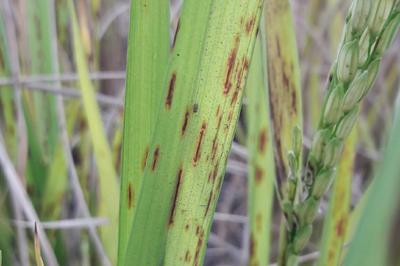Narrow Brown Leaf Spot of Rice
Sphaerulina oryzina
Fungus
In a Nutshell
- Linear lesions on the leaf axis.
- Progressive discoloration of leaf sheaths - "net blotch".
- Later spots appear.
- Premature ripening of kernels.
- Purplish-brown discoloration of seeds or grain.
Can also be found in
Symptoms
Linear leaf lesions develop which are 2-10 mm long and usually not more than 1-1.5 mm wide. The growth axis is parallel to that of the leaf. Lesions have a dark-brown centre with the border fading as the outer margin is reached. Lesions on the sheath are similar to those on the leaf, while lesions on the glumes and pedicel are shorter and tend to spread laterally. In resistant varieties, lesions may be narrower, shorter, and darker than those on susceptible varieties. Spots appear in later stages of growth, just prior to flowering stage. The disease can cause premature ripening of kernels and a purplish-brown discoloration of the seeds or grain. Lodging of plants has also been observed.
Recommendations

Organic Control
We don't know of any alternative treatment against Sphaerulina oryzina at the moment. Please get in touch with us in case you know of something that might help to fight this disease.

Chemical Control
Always consider an integrated approach with preventive measures together with biological treatments if available. If narrow brown spot poses a risk to the field, spray propiconazole at different stages of plant growth.
What caused it?
The disease usually occurs in potassium deficient soils, and in areas with temperature ranging from 25−28°C. It appears during the late growth stages of the rice crop, starting at heading stage. Alternate hosts allow the fungus to survive and infect new rice crops. Plants are most susceptible during panicle initiation onwards, and damage becomes more severe as plants approach maturity.
Preventive Measures
- Use resistant varieties if available in your area.
- Remove weeds and volunteer plants in the field and surrounding areas.
- Plan a balanced fertilization along the season.
- Make sure that adequate potassium is used.



